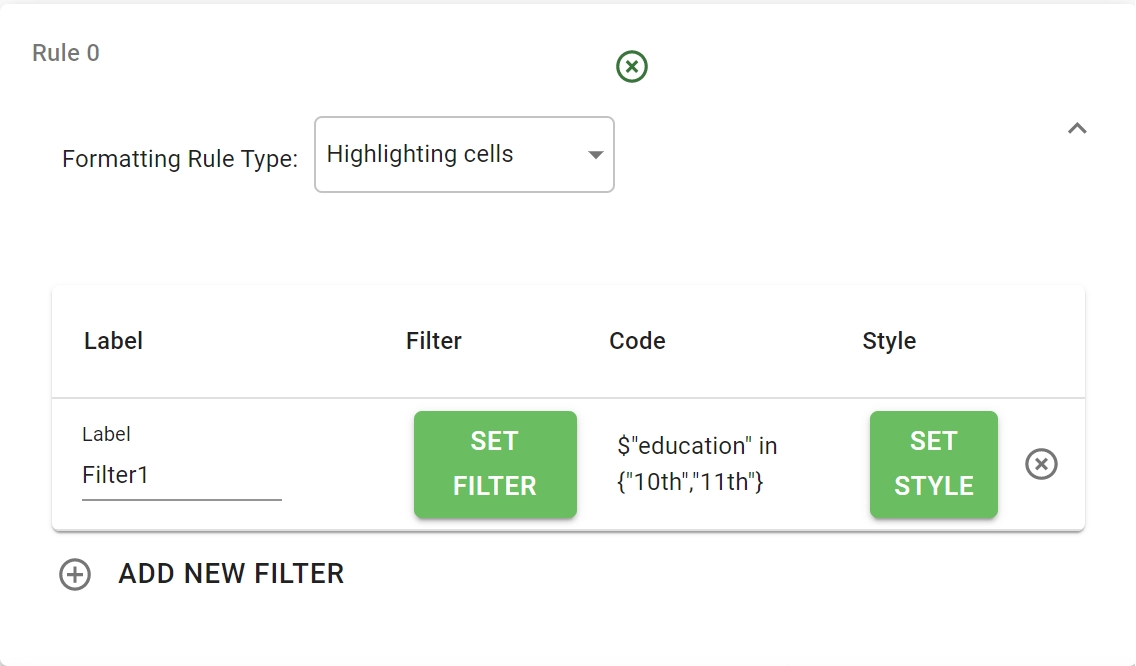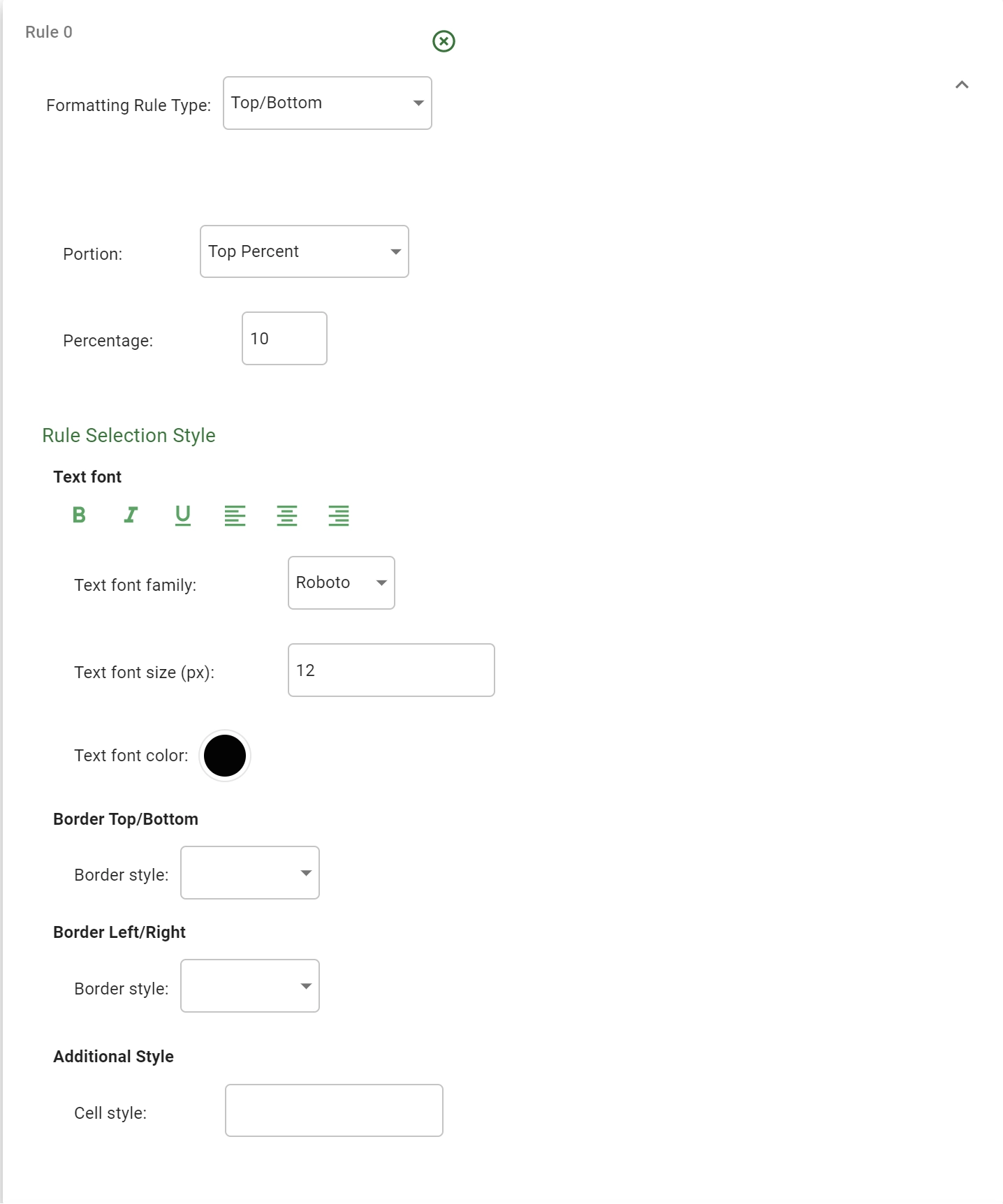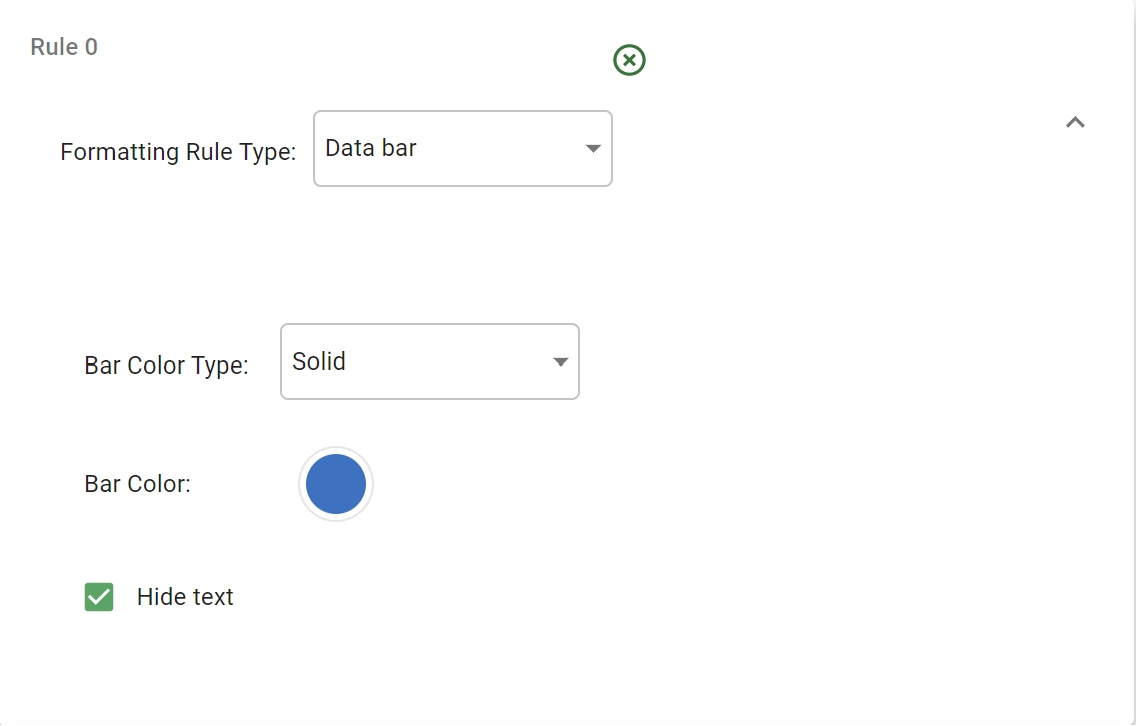Styling dataset columns¶
Dataset column style can now be changed and customized by the user; any modifications is then saved in the history and made persistent with the underlying dataset itself. This implies any subsequent child task will present the dataset together with its embedded style.
Style must be changed for the whole column; however, Rulex Factory offers two different customization tools:
Column default style: which allows the user to change the default style for the whole column i.e. its width, background color, text color or font etc…
Column conditional formatting: which allows the user to configure formatting rules for the whole column. These rules will change the style of the single cells according to their internal values.
You can modify the styling of a set of columns by using Set column style and Set conditional formatting entries in the header context menu from the main spreadsheet in the Data tab of the Data Manager task. This operation will open dedicated panels which are described in detail in the next sections.
Column style panel¶
In this panel you can customize the default style for a set of selected columns. The panel is divided into five different areas:
Size and background
Text font
Border bottom
Border right
Additional Style
In the Size and background area, you can customize:
Width: it changes the default column width by fixing the inserted value in px.
Background color: it changes the background color for all the cells of the column.
In the Text font area, you can modify the text style for the whole column:
Text styling option: it controls text style, weight, decoration and alignment.
Text font family: it modifies the font family for the cell text.
Text font size: it modifies the font size for the cell text.
Text font color: it modifies the font color for the cell text.
In the Border bottom and Border right area, you can modify the cell border style for the whole column:
Border style: it controls the dash style of the borderline.
Border width: it controls the width of the borderline.
Border color: it controls the color of the borderline.
In the Additional Style* area you can define your custom CSS code to be added as is to any cell style for the selected columns.
Conditional formatting panel¶
In this panel you can add and delete formatting rules for the selected columns. The panel presents you a list of rules into separated collapsible papers.
You can add a new rule by pressing the Plus icon in the line located at the bottom of the whole rule list.
Note
If you are selecting more than one column, only common rule are shown in this panel.
An already added rule can then be deleted by pressing the Cross icon located at the right end of the selected rule.
A single rule is first specified by its Formatting Rule Type. Available formatting rule type are:
Highlighting cells rule
A formatting Highlighting cells rule apply a series of defined styles to a subset of rows fulfilling an associated filter.
In any table line you can specify:
A label which is used only for documentation purposes.
A condition filter; once the SET FILTER button is pressed the condition panel associated to the selected attribute is shown: description of these panels are presented in these dedicated pages.
An associated style; once the SET STYLE button is pressed a panel equal to the just presented column style panel is shown: refer to previous section for a complete description.
Once the condition filter is defined for a row, its created code is visualized in the Code column of the table.
Top/Bottom rule
A formatting Top/Bottom rule applies a defined style to the top/bottom sector of your dataset.
You can define the top/bottom sector as a percentage or a fixed number of lines:
By defining a percentage the style will be applied to the first/last
xrow percent of the whole column.By defining a fixed number of rows the style will be applied to the first/last
xrows of the whole column.
The just exposed division type is controlled by the Portion drop down menu where you have to choose among:
Top percent
Bottom percent
Top lines
Bottom lines
In the Top percent or Bottom percent case, in the field Percentage you can specify the desired percentage as a number between 0 and 100.
In the Top lines or Bottom lines case, in the field Number of lines you can configure the number of considered rows.
Below this row selection criteria, you can specify the applied style in the Rule Selection Style area. This area is perfectly equal to the column style panel presented before: refer to previous section for a complete description.
Color scale rule
A formatting Color scale rule colors the cell background of the whole column using a defined colorscale.
Warning
This rule is not available for nominal or binary columns.
The panel is filled with a Color scale selector which allows the user to change the applied colorscale (Viridis colorscale is the default).
For a complete description about Color scale selector interaction please refer to this section.
Data bar rule
A formatting Data bar rule fills the cell background with a graphical horizontal bar with a width proportional to the value contained in the cell itself.
Warning
This rule is not available for nominal or binary columns.
The graphical bar can be further specified as:
Bar Color Type: the bar can have a Solid color background or a Gradient color one. Pick the desired value from the dropdown menu.
Bar Color: it specifies the solid background or the color used to construct the gradient background for the bar.
Hide text: checkbox to control if you want to hide the text in the various cell and left only the bars to represent the whole column.
Icon set rule
A formatting Icon set rule associates to any cell a particular icon based on the value contained in the cell itself. The icon is by default shown at the left of the already present text.
Icon associations can be defined to be Automatic or Custom. To select one of the two use the Test type radio button. The behavior will be:
In the Auto case the whole range of values from
maximumtominimumis divided innranges withnequal to the number of different icon for the selected iconset. Then, to any range the corresponding icon is associated.In the Custom case, you have to associate to
n-1icons (withnequal to the number of different icon for the selected iconset) a dedicated filter condition. The last remaining icon will be associated to any line not fulfilling any of the precedent conditions.
Warning
For nominal or binary columns, only the Custom behavior is available.
In the Custom scenario a dedicated filter table is added at the bottom of the panel. In any row a particular icon is presented. To the left of any icon a checkbox is placed to allow the user to define the icon default. The single line which is not checked represent the default associated to any line not fulfilling any of the precedent conditions.
To configure the filter associated to a single icon, you have to click the SET FILTER button on the corresponding line. This will open the condition panel associated to the selected attribute: description of these panels are presented in these dedicated pages. Once the condition has been created the corresponding condition code will appear in the Code column of the table.
Tip
To this configuration, you can further specify the Hide text option to hide the text in the cells of the column. If checked, the associated icon will be placed centered with respect to the whole cell.



